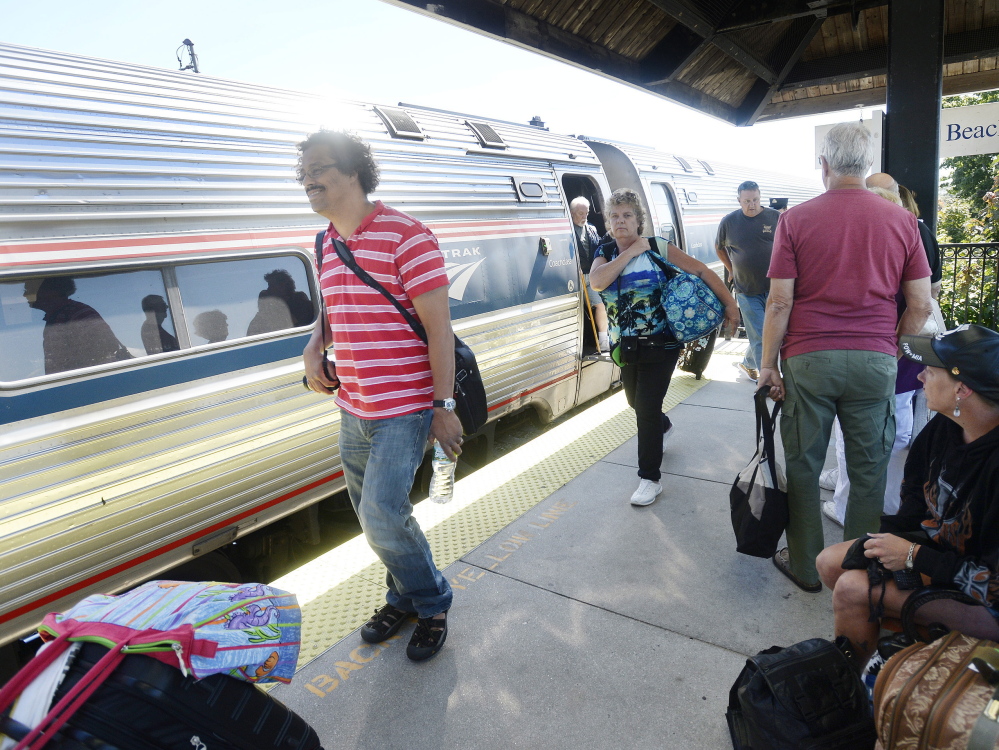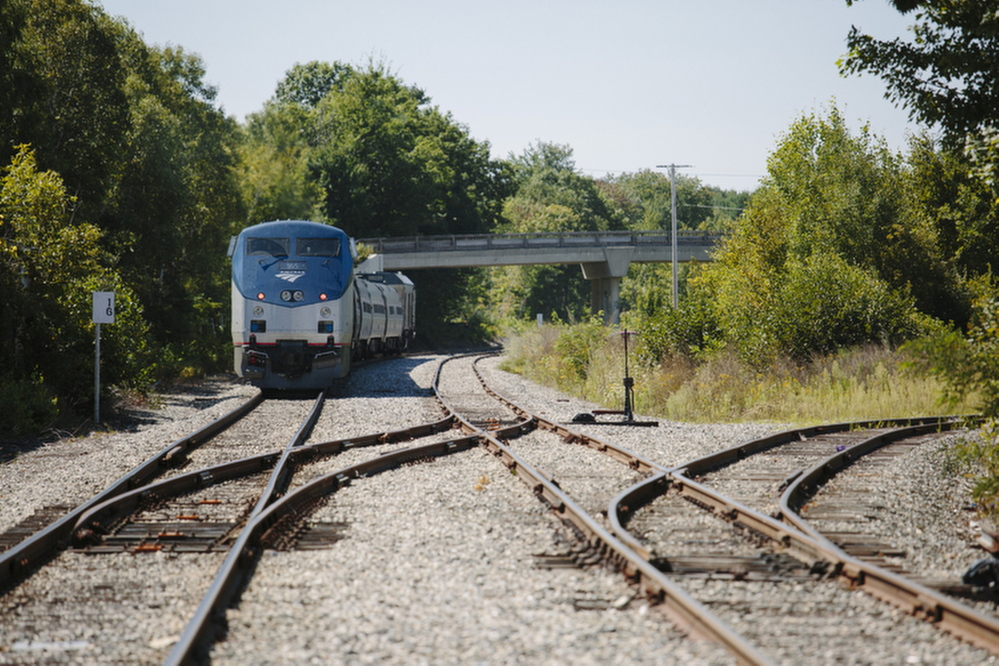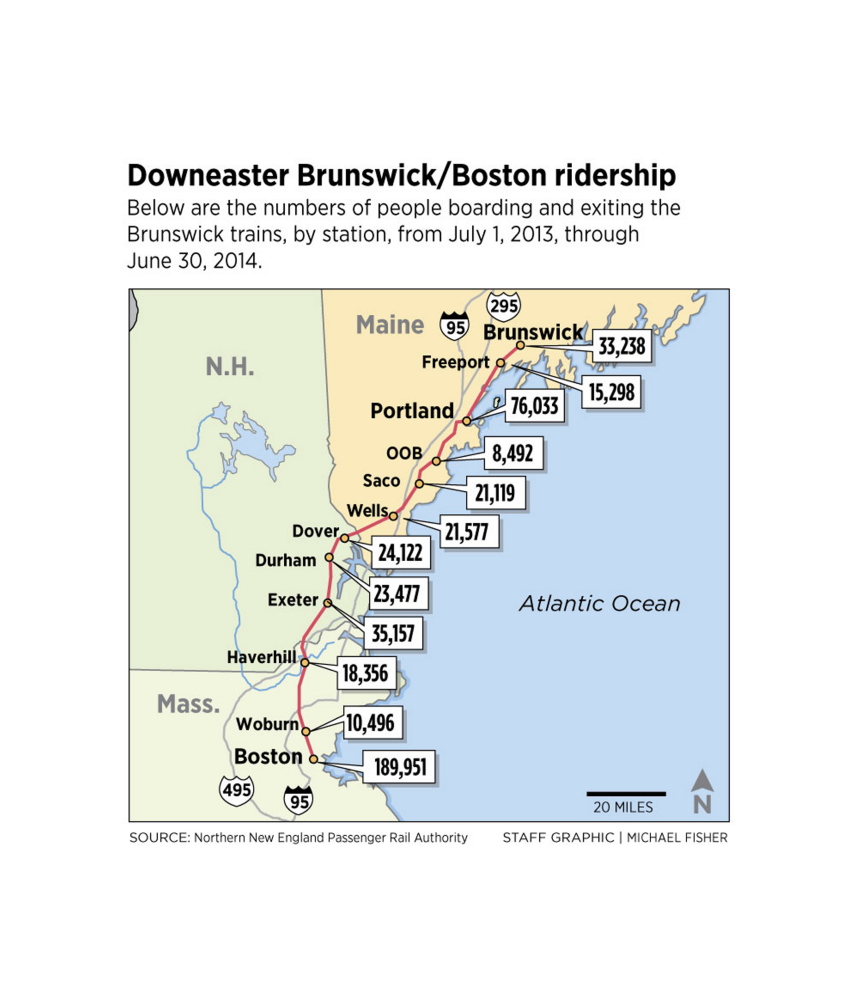For two years now, the battle over Amtrak’s plans to build a layover facility in Brunswick has been focused on the proposed site, a former rail yard near a residential neighborhood just south of the downtown station. But opponents are now criticizing the viability of the rail service itself, saying that too few passengers ride the train to justify building a $12.7 million facility and adding more train trips to the Brunswick schedule.
In 2013, only about 80 trains arrived or left Brunswick with 50 or more passengers, the amount needed to fill a single inter-city bus, according to a passenger count completed by a volunteer from an opposition group. The group’s initial argument cited noise and potential pollution as disruptions in their neighborhood, but now the scope of the opposition has widened.
“The expansion doesn’t make sense when you are not using the capacity you already have,” said Charles Wallace Jr., an environmental engineer who owns a company that abuts the site of the proposed 60,000-square-foot layover facility.
He and other opponents say the facility should be built along the busier Portland-to-Boston section of the service and in a more central location, like Portland or South Portland. Some Brunswick residents who support building the layover facility in Brunswick, however, worry that the opposition group’s tactics could jeopardize plans to improve the service with more train trips and also could make the service so costly that Amtrak could eventually abandon it.
“I think the neighborhood group would be happier if the train just went away,” said Emily Boochever, 62, a Brunswick resident who takes the train to visit friends in New York City and family in Washington, D.C. “They would rather kill off the Downeaster north of Portland than see the layover facility built where it is.”
A QUESTION OF PERSPECTIVE
Officials with the rail authority that operates the train service say the proposed facility would allow the service to operate more trains and increase ridership, while at the same time lowering operating costs, particularly for fuel and overtime pay.
Moreover, they say the ridership on the train north to Brunswick, which began service in November 2012, has exceeded their expectations.
The number of people riding the train is not being disputed. Rather, the difference is perspective.
The neighborhood critics look at individual trains and accurately see more empty seats than passengers. Since the service began, the Brunswick station has averaged 95 people arriving and departing daily, and Freeport has on average 46, according to the Northern New England Passenger Rail Authority, a quasi-state agency that has a contract with Amtrak to operate the service.
On average, each train arriving or leaving Brunswick has 24 passengers. Trains traveling north of Portland have a capacity of between 226 and 296 passengers, depending on the train.
Moreover, because passenger counts in Brunswick spike during certain times of year, such as during school vacations and holiday weekends, the averages are skewed.
Opponents of the layover facility look at statistics like these and conclude that 90 percent of the trains arriving or departing Brunswick are only 10 percent full.
Most businesses would not invest millions of dollars to expand if there was no or little demand for their product, Bob Morrison, chairman of the Brunswick West Neighborhood Coalition, wrote in a letter published last month in two local newspapers. “In the case of the Downeaster between Brunswick and Portland, there sure seems to be enough ‘product’ – available seats – but not very many customers.”
Some opponents have cited the public subsidy of the rail service as a reason to oppose its expansion. In fiscal year 2014, the rail authority spent $18.3 million to operate the train and received $8.6 million in revenue from ticket sales. The service required a subsidy of $8.4 million, of which the federal government picked up 80 percent. Maine’s contribution was $1.7 million, money that came from the Maine Department of Transportation’s tax on rental cars.
COMPARING SYSTEM RIDERSHIP
But officials at the rail authority take a wider look. They view the Brunswick station as one of 12 in a system, with each station making a contribution to the whole.
From that perspective, the expansion north of Portland was a success, exceeding Amtrak’s initial ridership projection of 100 daily passengers when Brunswick and Freeport customers are combined. And the train would attract more ridership with more frequent service, said Patricia Quinn, executive director of the rail authority.
The Downeaster service offers 10 one-way train trips a day, and four of those trips begin or end in Brunswick. For three of those Brunswick trains, there are more passengers departing or boarding there than any other station in the system except Portland, Quinn said.
In the fiscal year that ended June 30, for example, 6,700 people in Brunswick boarded the weekday southbound train that leaves Brunswick at 7:05 a.m. Only Portland, where 16,600 people boarded the train, had more boarding passengers. Saco was third with 5,100 passengers and Wells was fourth with 4,800.
Brunswick is also the second-most popular destination for the northbound train that leaves Boston at 9:05 a.m. on weekdays. The top station was Portland, where 10,200 people disembarked. Brunswick was second with 4,900 and Freeport was third with 2,500.
But the relative popularity of each station can be measured another way.
When arrival and departure numbers for the trains that travel to Brunswick are combined, Boston by far is the busiest station on the route, with 190,000 passengers boarding or exiting at North Station. A distant second is Portland with 76,000 passengers. Third place goes to Exeter, New Hampshire, which is dominated by residents who commute to Boston, with 35,000 passengers. Brunswick is in fourth place slightly behind Exeter with 33,000.
The popularity of the train in the southern end of the route makes it hard to fill the train in Brunswick, Quinn said. That’s because many of the trains that serve Brunswick sell out farther down the line. So a prospective customer who wants to board in Brunswick and travel to Boston may not be able to reserve a seat because all the available seats for that train are reserved by passengers who will board farther down the line.
That’s especially true for trains favored by commuters, such as the No. 681, which leaves Boston on weekdays at 9:05 a.m., and the No. 685, which leaves Boston at 5 p.m.
The busiest southbound train is also a commuter favorite – No. 682, which leaves Brunswick on weekdays at 7:05 a.m. In July, for example, that train was sold out for 18 of the 22 times it operated, Quinn said.
Because Amtrak offers only two round-trip trains daily to Brunswick and Freeport, potential passengers have few options, which limits ridership, she said. Those options dwindle even more when trains get sold out.
People who want to take the 7:05 a.m. train to Boston and return to Brunswick or Freeport at the end of the workday, for instance, will often find they can’t make the trip because either the southbound train is sold out or the northbound train that leaves Boston at 5:05 p.m. is sold out.
“They can’t get there, or they can’t get home, or both,” she said.
DIFFERENT LOCATIONS SUGGESTED
The rail authority plans to build a layover facility adjacent to the main line in an area about 5,000 feet south of the downtown station in Brunswick. The facility – essentially a garage – is wide enough to cover three multi-car trains at one time.
Currently, the rail authority stores three trains and some spare cars outdoors overnight in Portland adjacent to the station.
Quinn said the stored trains have to be kept running at a low idle year-round. In winter, the engines provide heat to keep lube oil from gelling. In summer, the engines provide power to produce compressed air for maintaining the brakes and to keep various operating systems functioning.
Sheltering the trains and providing a power source would allow the rail authority to shut down the trains overnight, saving fuel costs and reducing emissions.
Opponents of the Brunswick project say the rail authority should build the facility where the trains are stored now, or in South Portland in the Rigby rail yard, which is far from residential homes.
It’s foolish, they say, to spend nearly $13 million to build the layover facility in Brunswick on a line with relatively few passengers and where it would be stranded if Amtrak were to some day cut funding and eliminate the Brunswick service.
Rather, they say, it makes sense to build the facility in the Portland area in a central location so it could also shelter trains if passenger service is one day extended to Auburn and Lewiston and perhaps as far as Montreal.
“Having the facility way off to the east at the end of the line in Brunswick doesn’t do anything for the big picture,” said Rep. Mike Shaw of Standish, one of six Democratic lawmakers who in a letter in June urged the rail authority to build the layover facility in South Portland. Shaw, a veteran Amtrak conductor, works on Downeaster trains.
The lawmakers worry that building the layover facility in Brunswick would make it more difficult for passenger service to be expanded westward.
Moreover, if Amtrak should ever rethink its business model or if Maine officials should decide that the 29-mile route between Portland and Brunswick is untenable, the proposed layover facility in Brunswick could become a “colossal and embarrassing single-purpose ‘white elephant,’ ” said George Betke of Damariscotta, writing in The Other Side of Town, a conservative Brunswick blog that has been critical of the rail authority and the layover facility proposal. Betke has an ownership stake in several small freight railroads outside New England.
RAIL AGENCY: brunswick is best site
Quinn said that building the facility in Brunswick makes the most sense because Brunswick is the end of the line.
As it works now, Amtrak has to move an empty train from Portland to Brunswick at 6 a.m. every day so it can be ready to depart Brunswick with customers at 7:05 a.m. Every night, after the last train arrives in Brunswick, the empty train heads back to Portland so it can be parked overnight.
Currently, the three crew members on each train start and end their shifts in different stations – either Portland or Brunswick – so Amtrak must hire a taxi to take them back to the station where they started their shifts to get back to their cars. Amtrak also pays them overtime during their cab ride.
“Paying an hour of overtime for three crews to sit in a damn taxi drives me nuts,” Quinn said.
Locating a layover facility in South Portland to serve Lewiston and Auburn would only increase costs by requiring even more trains to make empty runs in two different directions, with “dead head” runs to Brunswick and Lewiston-Auburn, Quinn said. That’s because the two services would be operated by separate trains that would begin their days at the two ends of the line.
If Amtrak and the state ever decided to extend service to Lewiston-Auburn, she said, Amtrak would build a layover facility at the end of that line as well.
The rail authority is now spending $172,000 a year just for fuel costs to move empty trains to and from Brunswick, she said, and the total cost, including increased labor for crew overtime, is $441,000 annually.
Most of those costs would be eliminated if the layover facility were built in Brunswick, she said. If trains can stay overnight in Brunswick, Amtrak could offer passengers a third round-trip service daily with no additional fuel or labor costs. The additional service would give passengers more trip options, reduce the number of sold-out trains, and boost ridership and revenues, she said. She also noted that the work day for crews traveling between Brunswick and Boston amounts to one eight-hour shift, so there would be no additional labor costs.
“The Downeaster service is a Brunswick-to-Boston service,” Quinn said. “Having a layover at the end of that line maximizes the efficiency of that service and allows it to grow.”
Send questions/comments to the editors.






Success. Please wait for the page to reload. If the page does not reload within 5 seconds, please refresh the page.
Enter your email and password to access comments.
Hi, to comment on stories you must . This profile is in addition to your subscription and website login.
Already have a commenting profile? .
Invalid username/password.
Please check your email to confirm and complete your registration.
Only subscribers are eligible to post comments. Please subscribe or login first for digital access. Here’s why.
Use the form below to reset your password. When you've submitted your account email, we will send an email with a reset code.